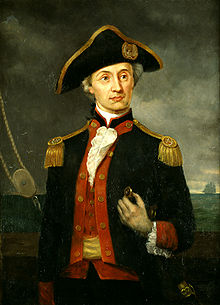United States Navy
Contents[show] |
[edit] Mission
The mission of the Navy is to maintain, train and equip combat-ready Naval forces capable of winning wars, deterring aggression and maintaining freedom of the seas.—Mission statement of the United States Navy[7]
The mission of the United States Navy is to protect and defend the right of the United States and our allies to move freely on the oceans and to protect our country against her enemies.
- "The preparation of naval forces necessary for the effective prosecution of war"
- "The maintenance of naval aviation, including land-based naval aviation, air transport essential for naval operations and all air weapons and air techniques involved in the operations and activities of the Navy"
- "The development of aircraft, weapons, tactics, technique, organization, and equipment of naval combat and service elements".
- USS Arizona (BB-39) was a Pennsylvania-class battleship, best known for her cataclysmic and dramatic sinking, with the loss of 1,177 lives, during the Japanese attack on Pearl Harbor on 7 December 1941, the event that brought about U.S. involvement in World War II. The USS Arizona Memorial is constructed over the shattered hull, which still contains the remains of most of the crew. It is commonly—but incorrectly—believed that Arizona remains perpetually in commission, likely because naval vessels entering Pearl Harbor render honors to the remains of the vessel.
- USS Enterprise (CV-6), a Yorktown-class aircraft carrier, was the most decorated U.S. warship in World War II, earning 20 of 22 possible battle stars. She was the only ship outside of the British Royal Navy to earn the Admiralty Pennant, the highest award of the British, in the more than 400 years since its creation.
- USS Missouri (BB-63), an Iowa-class battleship, was the site of the surrender of the Empire of Japan which ended World War II. She was also the last battleship built by the United States. In 1955, she was decommissioned and assigned to the inactive reserve fleet (the "Mothball Fleet"), but reactivated and modernized in 1984 as part of the 600-ship Navy plan, and fought in the 1991 Gulf War. Decommissioned in 1995, she was the last actively serving battleship in the world. She was donated to the USS Missouri Memorial Association in 1998 and became a museum ship at Pearl Harbor, moored facing the USS Arizona.
- USS Nautilus (SSN-571), a submarine commissioned in 1954, was the world's first nuclear-powered ship. It demonstrated its capabilities by traveling 62,562 miles (100,684 km), more than half of which was submerged, in two years before having to refuel while breaking the record for longest submerged voyage, as well as being the first submarine to transit submerged under the North Pole in 1958.[65]
- USS Liberty (AGTR-5) was a neutral United States Navy technical research ship, attacked by Israeli jet fighter planes and motor torpedo boats on June 8, 1967, during the Six-Day War while in international waters off the Sinai Peninsula.
- USS Skate (SSN-578), a nuclear-powered submarine commissioned in 1957, was the first ship to physically reach the North Pole when she surfaced there in 1958.
- USS Triton (SSRN-586), a nuclear-powered submarine commissioned in 1959, made the first submerged circumnavigation of the world during its shakedown cruise in 1960, as well as being the only non-Soviet submarine to be powered by two nuclear reactors.
- USS George Washington (SSBN-598), commissioned in 1959, was the first ever ballistic missile submarine.
- USS Long Beach (CGN-9) was the first nuclear-powered surface warship in the world when she was commissioned in 1961 and signaled a new era of United States naval weaponry by being the first large ship in the Navy to have guided missiles as its main battery.
- USS Enterprise (CVN-65) was the world's first nuclear-powered aircraft carrier when she was commissioned in 1961.
- USS Pueblo (AGER-2) was boarded and seized by the Democratic People's Republic of Korea (North Korea) on 23 January 1968 and is still under Korean control. The ship remains in commission to this day.
- USS Stark (FFG-31) was struck on May 17, 1987 by two Exocet antiship missiles fired from an Iraqi Mirage F1 fighter during the Iran–Iraq War becoming the victim of the only successful anti-ship missile attack on a U.S. Navy warship.
- USS Samuel B. Roberts (FFG-58) is an Oliver Hazard Perry-class frigate which struck an Iranian mine on 14 April 1988, severely damaging, and nearly sinking her, resulting in ten injured sailors, but no fatalities. The ship suffered flooding, fires, and a broken keel, which normally is fatal to the ship, but damage control efforts saved the ship. The attack resulted in the launching of Operation Praying Mantis. The ship is still in active service.
- USS Vincennes (CG-49) is a Ticonderoga-class AEGIS equipped guided missile cruiser. In 1988, the ship shot down Iran Air Flight 655 over the Persian Gulf, killing all 290 civilian passengers onboard including 38 non-Iranians and 66 children.
- USS Cole (DDG-67) On 12 October 2000, while at anchor in Aden, Yemen, the Cole was attacked by Al-Qaeda suicide bombers, who sailed a small boat near the destroyer and detonated explosive charges. The blast created a hole in the port side of the ship about 40 feet (12 m) in diameter, killing 17 crewmembers and injuring 39.
- USS Olympia (C-6) was a protected cruiser during the Spanish-American War. She is most notable for being the flagship of Commodore George Dewey at the Battle of Manila Bay. Olympia is the world's oldest steel warship still afloat. She also carried the Unknown Soldier to the United States after the First World War.
[edit] Notable sailors





